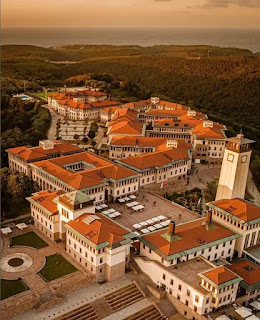Istanbul, a city where East meets West, is home to some of Turkey’s most prestigious private universities. These institutions offer world-class education, cutting-edge research facilities, and globally recognized programs that attract students from all over the world. In 2025, several private universities in Istanbul have risen to prominence in global rankings, thanks to their academic excellence, strong industry partnerships, and international outlook. Whether you're interested in medicine, engineering, business, or social sciences, Istanbul’s top private universities provide a rich blend of quality education and cultural experience.
1. Koç University – Sarıyer, Istanbul (European Side)
Koç University is widely regarded as the best private university in Turkey. Located in the serene area of Sarıyer, it boasts a large, modern campus and strong English-taught programs. The university excels in research, medicine, engineering, and social sciences. It consistently ranks in the top 100–150 universities worldwide due to its international faculty, research funding, and partnerships with global institutions.
Why It’s on Top:
-
Highest global ranking among Turkish privates
-
Strong in research and graduate employment
-
English-medium instruction and scholarships
2. Sabancı University – Tuzla, Istanbul (Asian Side)
Sabancı University is a research-driven institution known for its interdisciplinary approach. Located in Tuzla, its modern campus supports innovation in engineering, natural sciences, and business. It ranks among the top 150 globally.
Why It’s on Top:
-
Flexible academic structure
-
Strong industrial and academic partnerships
-
Focus on innovation and entrepreneurship
3. Istanbul Medipol University – Bağcılar/Kavacık (Both Sides)
Medipol has gained fame due to its focus on medical sciences, pharmacy, and health sciences. With campuses on both the Asian and European sides, it offers high-quality practical education supported by its own hospital network.
Why It’s on Top:
-
Leading university in health and medical research
-
Large clinical practice network
-
Rapid rise in national and international rankings
4. Yeditepe University – Ataşehir, Istanbul (Asian Side)
Yeditepe is known for its comprehensive programs ranging from engineering to dentistry. The university offers an American-style education with English as the medium of instruction. Its main campus is modern and tech equipped.
Why It’s on Top:
-
Wide academic program range
-
English-medium instruction
-
Strong alumni network and job placement
5. Acıbadem Mehmet Ali Aydınlar University – Ataşehir, Istanbul (Asian Side)
Acıbadem is a top institution in the medical and health sciences fields. Affiliated with the prestigious Acıbadem Healthcare Group, it provides hands-on medical education with modern laboratories and hospitals.
Why It’s on Top:
-
Strong industry integration (Acıbadem Hospitals)
-
Leading in medical education
-
State-of-the-art facilities
6. Istinye University – Sarıyer/Topkapı, Istanbul (European Side)
Istinye University is relatively new but has quickly risen in rankings due to its research-oriented environment and strong backing from the MLPCare healthcare group. It offers programs in health, technology, and business.
Why It’s on Top:
7. Bahçeşehir University – Beşiktaş, Istanbul (European Side)
Located in the heart of Istanbul, Bahçeşehir University is known for its international outlook. It has global campuses and exchange programs in the U.S., Germany, and Canada. The university excels in engineering, business, and media.
Why It’s on Top:
8. Istanbul Bilgi University – Eyüp/Santral, Istanbul (European Side)
Bilgi University is a liberal and progressive institution, especially strong in law, media, and social sciences. It is one of the few Turkish universities ranked in global QS rankings. The Santral Campus is located at a former power plant turned cultural center.
Why It’s on Top:
-
Creative, liberal arts focus
-
International recognition
-
Culturally rich and innovative campus
9. Özyeğin University – Çekmeköy, Istanbul (Asian Side)
Özyeğin University is a research-oriented institution with a beautiful green campus in Çekmeköy. It is known for its entrepreneurship and innovation culture, and its business and engineering schools are highly ranked.
Why It’s on Top:
-
Entrepreneurial ecosystem
-
Scholarships and modern campus
-
Rising research productivity
10. Kadir Has University – Cibali, Istanbul (European Side)
Kadir Has University is located near the Golden Horn and has a strong focus on humanities, international relations, and design. It’s a mid-size university that combines tradition with modern academic offerings.
Why It’s on Top:
-
Central location in historic Istanbul
-
Well-known programs in arts and politics
-
English-medium education and international ties
These universities are at the top not only because of academic performance but also because of strong global ties, industry integration, English-taught programs, and active research environments. Each one offers something unique, whether it's health sciences, engineering, social impact, or business education. For international students or local scholars seeking quality education in Istanbul, these ten are the best private options as of 2025.





